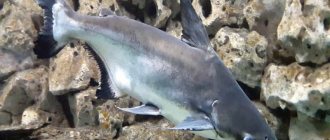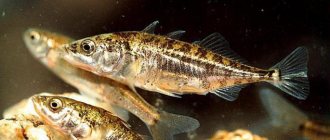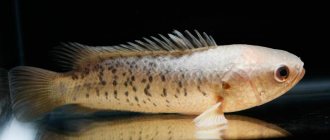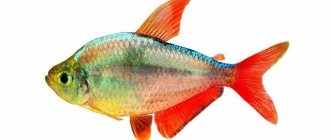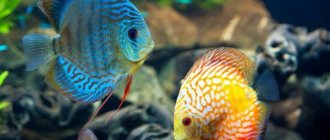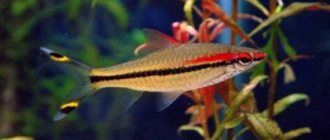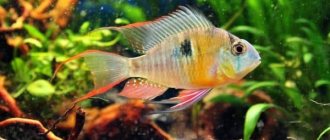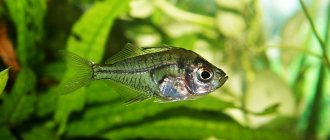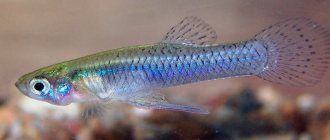Origin of the species and description
The needle family has 298 species. Of the total number, 244 species are needle fish, combined into one subfamily. The remaining 54 species are seahorses.
The length of needle fish can vary and ranges from 2.5 cm to 0.6 m. However, all species are characterized by common features:
- Elongated elongated body.
- The snout is tube-shaped. Its length varies depending on the species.
- A long tail with which the fish can cling to objects and algae.
- Small or absent caudal fin.
- Absence of pelvic fins.
- The pectoral fins serve as the main organ of locomotion. In some species they disappear at a certain age.
The color can be varied: from white to brown. Some species are bright and have contrasting or colored stripes, others are gray with spots. There are species that can change their color in accordance with the external environment.
The family consists of 298 species of fish included in 57 genera
Fish stew
- Fish fillet 500 g;
- Potatoes -200 g;
- Beetroot - 1 piece;
- Cabbage – 200 g;
- Zucchini – 1/3 pcs;
- Tomatoes -200 g;
- Butter - 1 tbsp;
- Onion -2 pcs;
- Bell pepper – 1 piece;
- Dill parsley to taste;
- Sour cream – 2 cups;
- Broth 100 ml;
- Bay leaf - 1 piece;
- Salt to taste.
Preparation
- Chop the pepper and onion into half rings.
- Fry with cabbage and tomatoes (pre-cut).
- Peel 1/3 of the zucchini and grate on a coarse grater.
- Cut the fillet into slices.
- Place the vegetables in the pan and place the fish pieces in the middle.
- Add chopped dill, parsley, bay leaf.
- The top should be lined with tomatoes.
- Pour a glass of broth, after adding sour cream.
- Cover with a lid and place in the oven for 2 hours (on low heat).
Cooking time 2.5 hours.
Cooking time – 2 hours.
Number of servings – 10.
Calories - 776, fats -82, carbohydrates - 67, proteins -1.9.
Are needlefish and garfish the same thing?
The garfish and needlefish are united only by the common class of ray-finned fish. Almost 95% of all known individuals belong to this category.
The garfish is often called the needlefish, however, people gave it this nickname because of its shape and sharp beak. The similarity with needlefish lies in the elongation of the body and head. All species of garfish have pelvic, pectoral, anal and dorsal fins. The mouth, unlike the needle, has the shape of a beak and is studded with sharp teeth. The garfish family includes several varieties, the sizes of which differ from each other. The largest crocodile species reaches a length of 1.5 m.
Attention!
Unlike pipefish, the predatory garfish does not hunt crustaceans, but small fish: sprat, herring, anchovy, young mackerel and herring. During the hunt, the fish can develop high speed, jump out of the water, and make sharp jerks.
Appearance and features
Let's look at the main characteristics of what an adult pipefish looks like. The body of the fish is elongated, with hard bone thickenings located along its entire length. The mouth is represented by a long “pipe” without teeth.
The color can range from yellow to dark brown. There are species with a reddish and greenish tint, the surface of some of them is covered with spots.
Appearance and habits allow the fish to camouflage itself with environmental conditions. In a static state, with their tail attached to the ground or other surface, the fish resemble algae.
Living in the wild
The fish is widely distributed in many habitats.
Area
Some of the most poisonous representatives of aquatic fauna prefer to occupy territories such as Ceylon, the Philippines, Malaysia, Indonesia, India and other countries.
The hedgehog fish (or its second name is tetraodon) is found in the following waters:
- Congo;
- Amazon;
- Southern Primorye;
- Southeast Asia.
There are fish of various shapes, types and sizes. For example, dwarf individuals live in southern India in sandy ponds. Only sometimes fish from tropical waters are carried by currents to temperate latitudes. Most often, spherical individuals settle near coral growths in order to hide if necessary. With a feeling of security, tetraodon becomes less irritable and angry. Individuals wake up at dawn and fall asleep at sunset.
Character and lifestyle
The pipefish moves smoothly. The tail serves as a support; when stopping, the fish rests it on the ground.
An underwater resident can spend a lot of time hunting. The structure of the body allows you to bend and take unusual poses.
Needles have good eyesight, thanks to which they notice crustaceans hidden in the most secluded places. Large eyes always carefully examine the surroundings.
When prey is detected, the needle freezes, the snout is located not far from the victim. When crustaceans approach, she spreads her gill covers and with a sharp movement of her head instantly sucks in the prey.
Where does it live?
Most pipefish choose warm waters in the coastal zone, where the substrate is sand, often living among algae and corals. Species living in the depths of the sea are rare.
The habitat of most needlefish is the Eastern Atlantic. Common fish are more often found in the Caspian, Baltic, Black, Azov and Aral seas. At the same time, rarer species can be found in coastal zones and fresh water bodies around the world. The needle family is represented by river, brackish-water and sea fish.
Some species live in the lower reaches of rivers. The construction of dams on rivers changes the ichthyofauna, as a result of which needle fish rise up against the current. For this reason, the species has mastered the Middle Volga and rises even higher, penetrating into other rivers.
Feeding
Tetraodon's main food is snails. Fish teeth grow continuously. If they don’t grind off on the sink, you’ll have to do it manually. Considering the thorns, this is an unpleasant procedure. Otherwise, the fish lose their appetite and get sick.
View this post on Instagram
Posted by My Puffer Fish And Turtles (@my_puffer_fish_and_turtles) May 5, 2021 at 4:57 am PDT
Let's give bloodworms, coretra, tubifex. Coretra is preferred: it is not particularly high in calories and forces the fish to hunt. Live food obtained from natural bodies of water can be dangerous due to toxins, parasites and infection. Use trusted suppliers.
Frozen food, sea fish fillets, shrimp meat, and boiled beef liver are suitable. If they eat plants, add plant food to the diet. Cucumber and cabbage, pumpkin and zucchini. Fortified food - crushed oatmeal, flakes.
Kinds
Among the many species of fish, the most common pipefish are:
- serpentine;
- ordinary.
The genus of serpentine needles includes 3 species living in the Eastern Atlantic:
- Worm-shaped pipefish (Nerophis lumbriciformis). The length of females reaches 17 cm, males are 2 cm less. The body is predominantly dark in color, the belly is light (from white to yellow). Pectoral and caudal fins are missing.
- Sea awl (Nerophis ophidion). It is found in aquatic regions from Norway to Morocco (excluding the territory from Denmark to the Netherlands), in the Mediterranean and Black Seas. at a depth of 2-15 m.
- Nerophis maculatus. Western part of the Mediterranean Sea, Adriatic Sea, the coast of Portugal and the Azores. The male reaches a length of 30 cm.
Common pipefish are divided into numerous species, among which the most famous are:
- Long-snouted pipefish. The body length reaches a maximum of 35 cm. The snout is compressed, its height exceeds the diameter of the eyes. Distributed in the Eastern Atlantic (Varde, Norway, the Baltic Sea and the British Isles to Morocco), in addition, it inhabits the entire Mediterranean, Black and Azov Seas. Habitat depth ranges from 1 to 20 m.
- Italian. The length can reach 21 cm. The snout is quite short if you compare the fish with other species. Inhabits vegetative underwater areas from Biscay to Gibraltar, the Mediterranean and Black Seas. Inhabits fresh waters (lower reaches of the Don, Volga, Danube, Dnieper, Western Bug rivers).
- Common pipefish. The maximum length is 50 cm. The color can be from light green to dark brown tones. The cylindrical snout is equal in diameter to the eye, and sometimes smaller than it. Pectoral and anal fins are missing. Found in coastal and estuarine waters at a depth of at least 110 m. Inhabits the Mediterranean, Aegean, and Black Seas. Distributed from Norway to Western Sahara, from Namibia to the Cape of Good Hope.
- Black Sea spiny. Maximum size - 11 cm. More often found at depths of up to 10 m, less often - up to 100 m. Inhabits the Black, Azov and Marmara seas. Found in coastal areas of Turkey. The diameter of the bulging eyes is 2 times the diameter of the snout. The back is grayish-bluish in color with black transverse stripes. The sides and belly are lighter.
- Thin-snouted needlefish. It lives in the southern regions of the Adriatic Sea, in the Tyrrhenian Sea. Less common in the Black and Azov Seas. The depth range is 3-20 m. It can reach 41 cm in length. There are dorsal, pectoral and anal fins. The eyes are small, but their diameter is larger than the snout. The body is rough, the color can vary between light gray or light brown shades.
- Thick-snouted. Inhabits the waters of the Black and Azov Seas. The length can reach up to 36 cm. There are dorsal, pectoral and anal fins. The color changes in light brown, gray and dark brown shades. The snout is long and high.
Longsnout pipefish
Italian pipefish
Common pipefish
Thick-nosed pipefish
Thin-snouted pipefish
Black Sea spiny
Interesting Facts
The life of a special inhabitant of the water depths has acquired a lot of interesting facts.
For example:
- according to scientists, males in nature attract a female by drawing a beautiful circle in the sand with their fins; the female chooses a partner based on the beauty of the circle;
- the poison of one fugu can kill 20 people;
- in 1500, the army died from poison, and after that the fugu delicacy was banned for two hundred years; in 1700, the official Hirobumu Ito appreciated the magic of the taste and lifted his veto on its preparation;
- customers who want to eat fugu are served sake infused with fish fins; this drink will significantly increase a person’s chance of staying alive even after serious poisoning;
- Every year in Japan, 15-20 people die trying to cook fugu with their own hands;
- The pufferfish (pufferfish) has no scales, the skin is elastic with small spines.
Keeping predators is not an easy task, but proper care and proper nutrition of the fish will help you gain new experience and surprise any visiting guest.
Care and maintenance
The pipefish moves vertically and requires a lot of space to swim. The volume of the aquarium for it must be at least 150 liters. To observe the birth of fry, you need to purchase a pair. However, babies in aquarium conditions die in most cases. Juveniles are particularly picky about food and feed only on zooplankton.
The fish are peaceful; in the aquarium next door there can be both large and small fish that will not decide to eat the needle.
It is necessary to pay attention to the conditions for live needle food. For a longer life of artemia and nauplii, it is recommended to add one tablespoon of sea salt per 10 liters of water.
Attention!
Species that live in fresh water do not need the addition of sea salt.
There are also more exotic types of needles. For example, Microphis deocata (rainbow freshwater pipefish) lives in clean water bodies of India. The unusualness of the fish lies in the appearance of the males. When meeting a female, their brood pouch opens up like a sail decorated with bright stripes. Under normal conditions, the bursa folds up and looks like a narrow, colored membrane on the abdomen.
The rainbow needle is difficult to transport. In captivity, it is difficult to find suitable conditions for it, so only professionals should purchase this type of fish.
The needle fish is very friendly towards humans and does not consider them an enemy at all.
Water parameters
Experienced aquarists recommend choosing an “old” (long-salted) aquarium.
Optimal parameters for common pipefish:
- temperature - 24-28 degrees;
- density - 1.023-1.028;
- pH - 5-7;
- dH - 5-15.
Acidaceae combines several genera. Environmental conditions for the most popular aquarium species may vary:
- Philippine microphys (Microphis brachyurus). In a community aquarium, they can remain hungry because they eat very, very slowly. pH - 7-8, dGH - 12-18, temperature - 24-28C.
- Large needle (Microphis boaja). Water temperature - 22-26C, salinity - 1-20%.
- African freshwater pipefish (Syngnathus ansorgii). Requires a large amount of vegetation that can comfortably tolerate brackish water. pH - 7-8, dH - 10-25, temperature - 24-28C.
- Syngnathus pulcellus. Salinity - 1-5%, dH 8-15, pH - approximately 7, temperature - 25-28C, in colder water there is a risk of illness.
- Black line pipefish (Syngnathus nigrolineatu). dH 15–30, pH 7–8, temperature - 18-20C (lives in cold water), salinity as required - 1-10%.
Comfortable conditions in the aquarium are created based on the natural habitat of the fish.
Lighting
Too much light causes algae blooms. Darkness and light should alternate, repeating natural living conditions. When the lamp is constantly on, fish feel discomfort and may lose their ability to reproduce. The optimal duration of the photoperiod is 13 hours. For convenience, lighting fixtures with automatic switching on and off are purchased.
The optimal volume of the aquarium is 300 liters
Vegetation
For needles, the presence of lush vegetation is important. In their natural environment, most species choose grassy areas for their habitat.
Note!
Needles feel comfortable if there are several clumps of caulerpa algae or other floating plants in the aquarium.
Pipe fish move slowly and constantly search for various larvae and crustaceans in the ground. They love to hide, so if they provide suitable support, aquarists will be able to enjoy observing the behavior of unusual fish. In a static position, the fish cling to plants and corals with their tails. It is possible to use artificial algae.
Priming
Coarse sand is poured onto the bottom of the aquarium. If it is possible to take soil from its natural habitat, then the fish will quickly adapt to new conditions. Species that live in corals will do better in coral sand.
Decor
To make the needles comfortable in the aquarium, it is necessary to create many spacious shelters in the form of grottoes, stone crevices and corals where the fish can hide. At the bottom you need to install several live stones. In addition to their decorative function, they will become a habitat for various small crustaceans.
It is especially important to have a sufficient number of shelters for fish that are housed with neighbors.
Nutrition
The tube-shaped snout allows it to suck in prey along with the water flow from a distance of 4 cm. In its natural environment, the needlefish feeds on small planktonic crustaceans. The fry, being in the father's pouch, feed from his circulatory system. After separation from the male, they initially feed on zooplankton.
Spinefishes hunt almost all the time. When keeping fish in an aquarium, it is necessary to ensure that cyclops or small daphnia are always in the water. Fish often refuse to eat chopped tubifex.
Aquarists note that in the absence of prey, needlefish quickly lose weight and may die. Difficulties with feeding often arise with fish caught from natural conditions. Fish raised in an aquarium quickly adapt to new food. Over time, they begin to eat highly chopped meat of mussels, shrimp and squid.
Adults prefer fish, frogs, shrimp, tadpoles, nauplii, planktonic crustaceans
Reproduction
The male quickly finds the female and attracts her with a kind of long dance. Eventually, the female wraps herself around the male and deposits her eggs in a leathery pouch on his abdomen. It happens that the caviar is placed in a special groove. For fertilization, the male receives several portions of eggs, 15-20 pieces each. Spawning can last several weeks; in total, one female transfers approximately 100 eggs to the male during the season.
The serpentine pipefish does not have a pouch. The eggs are attached to the male's abdomen and are not protected.
The eggs are kept in the bag until the fry hatch. Often they do not leave the bag for some time. Periodically, the male “walks” his cubs. He bends his body so that the bag can open. However, when danger threatens, the fry return to their father. The eggs receive nutrition from the blood vessels of the father.
Sex differences
Dimorphism in needle fish is weakly expressed. Their appearance is similar; males are often several centimeters shorter than females. The main difference is the structure of the reproductive system.
Males of most species have a special pouch for carrying eggs. Males of some varieties do without such folds and carry eggs on their abdomen. In this case, future offspring are more vulnerable to enemies.
The spawning period for needlefish begins in mid-spring
Poisonous delicacy
Every year, hundreds of thousands of people try to try a dangerous delicacy made from puffer fish or fugu, relying only on the professionalism of the cook. One wrong move and a fish delicacy can spell death for a restaurant guest. 60% of those poisoned by fish die within 24 hours; this is the time period that is considered critical.
Symptoms of fugu poisoning:
- After 15-20 minutes, a tingling sensation is felt in the lips, the tongue becomes numb, the clarity of movements is impaired, strong salivation and weakness in the muscles appear.
- If the portion of poison eaten is large, then the sensations soon spread throughout the body, accompanied by indigestion and vomiting.
- Death occurs from respiratory arrest, since the muscles that provide breathing cease to receive the necessary impulses from the brain.
- It has not yet been clarified why the poison does not affect the host itself, and why non-poisonous individuals, when placed in an aquarium with poisonous ones, also acquire the ability to poison.
How to cook safely
Even despite the poison and the threat of death (and perhaps that’s why), fugu fish is considered an elite treat.
Before serving this extreme treat, you should:
- wear sterile gloves;
- peel the meat from the skin to the slightest shred;
- gut the belly;
- Use tweezers to pull out the protruding bones;
- wash all parts of the carcass;
- cut the meat into slices and send to the table.
Inexperienced cooks should not cook fugu. The specialist must first undergo training in preparing pufferfish.
An interesting fact is that the chef’s highest culinary aerobatics is considered to be the ability to gut the fugu, leaving a little poison in it, which produces an effect on the client similar to drug intoxication.
The cost of such a delicacy reaches up to $1,000 from famous Japanese chefs.
Diseases and prevention
It is noted that when transferred from their natural habitat to an aquarium, fish experience stress and require time to adapt. In this case, most individuals develop mucus around the mouth and rear fin, and there is a risk of developing fin rot. The tail may fall off completely, after which it will recover.
After catching fish from reservoirs, they should be placed in a plastic container, gradually begin to aerate it, and fill it with a lot of hornwort, daphnia and cyclops. Very carefully and gradually add 10 drops of brilliant green into the water per 20 liters. This will help eliminate the risk of fin rot.
Water from the pond in which the needlefish lived should be left for a day just in case the fish feels unwell.
Compatibility and natural enemies
Needles are calm and peaceful fish. They feed on small crustaceans and plankton and are not interested in others. They can escape from a predator only through camouflage. Sharing games with predatory and very restless fish is not allowed.
Attention!
Peace-loving species of any size are suitable for living together. In this case, it is better to choose ornamental invertebrates for which needles do not pose any danger.
In their natural habitat, many animals and some insects pose a danger to needles. Aquarists have noticed that an interesting swimming beetle is capturing needlefish and gutting it.
The main causes of disease are poor quality water and feed.
The danger of flavors
Japanese chefs have a special license to prepare this type. People who wanted to cook the delicacy themselves with moderate skills died from muscle paralysis.
The poison is mainly found in the skin, liver, spleen, gall bladder and caviar. With any damage to these organs, a toxic substance leaks out of the cells and even in micro quantities can cause paralysis.
When fish is properly processed, poisoning of the body does not occur after consumption. The cooking technique itself was developed by Japanese chefs, who, after decades, shared it with Russian specialists.
Population and species status
Needlefish have no commercial value for humans; they are used as souvenir fishing objects. Lack of catching does not affect the decline in fish populations.
Some species are vulnerable to adverse environmental conditions. Thus, thick-snouted and thin-snouted needlefish are included in the Red Book of Ukraine and have the status “Vulnerable”. The reason is water pollution.
To preserve fish with this status, fishing is prohibited, and a reserve regime has been established in the discovered habitats.
Reviews
Pipefish are relatives of seahorses. They are similar in structure, but differ in their elongated long body. The species is widespread in marine coastal areas and freshwater bodies. Needles are heat-loving fish, so lowering the temperature in the aquarium below 24 degrees negatively affects their health. It is better for novice aquarists to choose local species of needlefish, for which it is not difficult to replicate the natural conditions of their habitat in captivity.
Would you like to purchase an Igloo Fish for your own aquarium? Share in the comments!
The nutritional value
Thanks to its nutritional value, richness in Omega acids and a large number of beneficial properties, needle fish is a welcome guest on any table. Omega acids increase people's immunity, improve hormonal levels and rejuvenate the body. Particularly tasty specimens must be caught in the fall.
The black sea predator contains a large amount of phosphorus and iodine, the consumption of which improves the functioning of the thyroid gland and supports brain activity, muscle activity and bone growth. A wide variety of dishes can be prepared from fish. You can serve it by pre-smoking, frying, possibly cooking in the oven or smoking.



